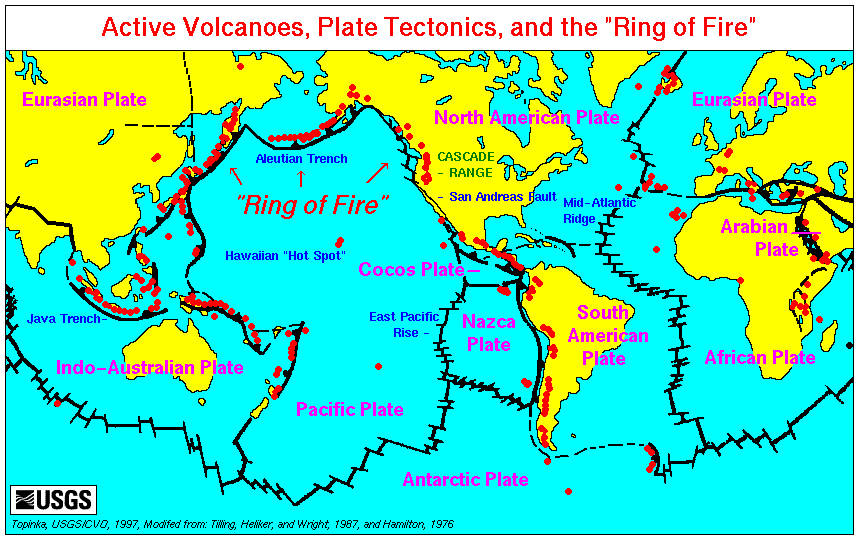Where do you find volcanoes AND What is the Ring Of Fire?
Volcanoes occur where magma rises through the Earth's crust and reaches the surface. To do this, the magma must find a weakness in the crustal rocks on either the land or under the sea.
Most of the volcanoes occur at, or close to, the edges of tectonic plates. In particular, they are found along plate margins from New Zealand, along the eastern edge of Asia, then north through the Aleutian Islands (Alaska) , and south down the coast of North and South America. This line of active and dormant volcanoes is known as the 'ring of fire' and includes more than 75% of the world's active and dormant volcanoes.

Because we know that volcanoes are created along plate boundaries we can safely assume that places with long extinct volcanoes (such as Edinburgh in Scotland, UK) must once have been positioned on a plate margin, even if they are now well away from one. It is possible for places to have once been on the edge of a plate and now be well away from one because the plates that make up the surface of the Earth are slowly moving, and have been doing so for millions of years. This process is called continental drift and was first suggested back in 1912 by a man called Alfred Wegener.
Places well away from plate boundaries rarely have volcanoes, although there are a few 'hot spots' where they do occur. The Hawaiian Islands, for example are entirely volcanic but no where near a plate margin. The are, in fact, 3200 km from the nearest boundary. A Canadian, called J.Tuzo Wilson, was the creator of the 'hot spot' theory. He suggested that there were some places on the planet that seemed to have been volcanically active for extremely long periods of time. Since they weren't close to plate boundaries they must have local sources of magma - small, long lasting, and extremely hot sources of rock under them. These thermal plumes can be seen as areas where the crust is thinned by uprising hot rocks, and weakened sufficiently to allow magma to rise to the surface. If you look at the Hawaiian Islands on a map you will see that they form a line. This was seen by Wilson as more evidence to back up his idea. He suggested that if the Pacific Plate was moving over the hotspot, and volcanic islands were created as the plate moved over the hot spot, a line of islands would be formed, with the oldest ones being furthest from the present hot spot. Tests on the Hawaiian Islands confirmed his hunch, with the islands furthest away being 5.5 million years old, whilst the one nearest the hot spot had no rocks older than 0.7 million years.
![]()
